


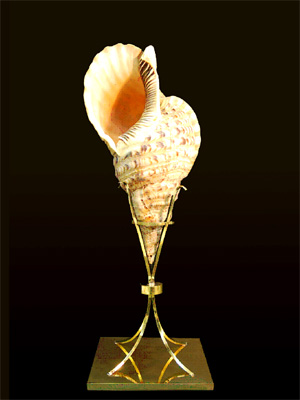
ホラガイ
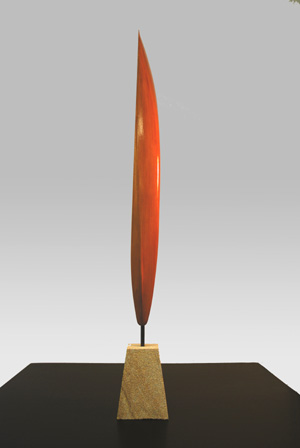
徳川模型
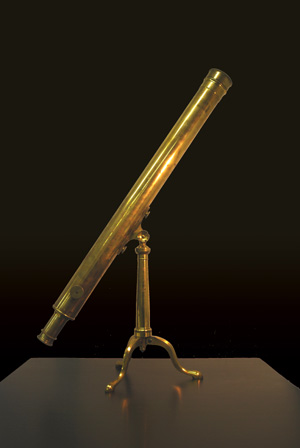
望遠鏡
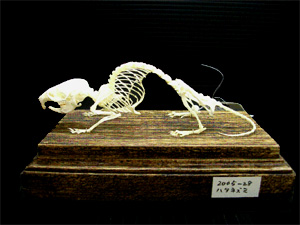
ハタネズミ
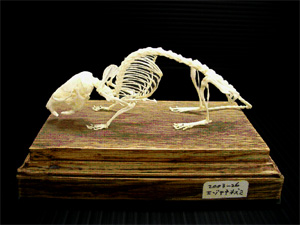
エゾヤチネズミ
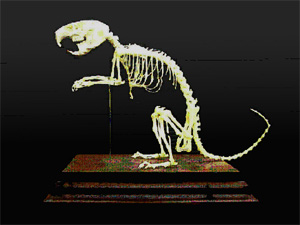
デグー
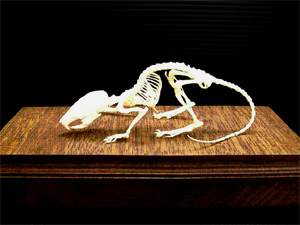
ドブネズミ
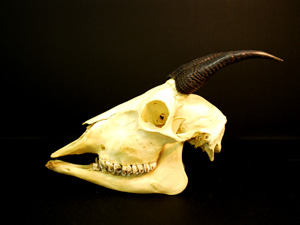
ニホンカモシカ
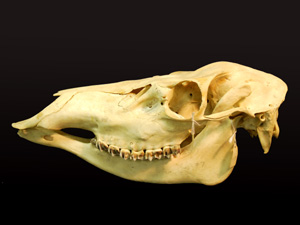
エルク
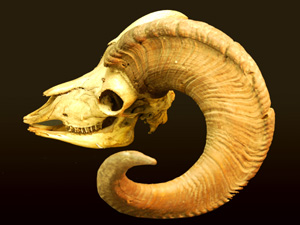
ヒツジ
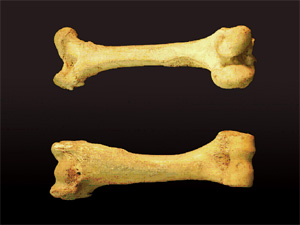
キリンの大腿骨・上腕骨
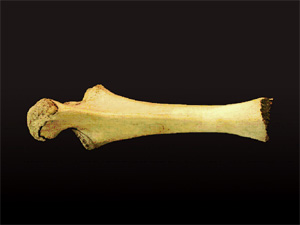
ゾウの尺骨

ゾウ類の脛骨
 展示標本 (2007.7.21-2008.2.1)
展示標本 (2007.7.21-2008.2.1)小ケース1: ホラガイ
殻は大型で殻長40cm以上に達するが、近年は大型の標本は入手が困難である。食性は肉食性でヒトデ類を好んで食べる。特に、サンゴの食害で悪名の高いオニヒトデの天敵として有名である。紀伊半島以南、主に奄美諸島以南の熱帯太平洋に広く分布し、浅海のサンゴ礁域に生息する。
Trumpet triton (Charonia tritonis)
The shell attains more than 40 cm in length, but large specimens are difficult to obtain recently. The animal is carnivorous and preferably preys on starfishes. This species is particularly well-known as a predator of crown-of-thorns starfish (Acanthaster planci) which has a frequently destructive effect on corals. The habitat is south to Kii Peninsula, mainly from Amami Islands to tropical Pacific, and lives in shallow-water coral-reef environments.
小ケース2: 徳川模型
流体から受ける推進抵抗と運動体の形状の相関性を実験的に検証するための模型。実験を主導した徳川武定(1888―1957)は東京帝国大学造船学科を卒業後、海軍技術研究所長、海軍技術中将、東京帝国大学教授、子爵となった人物で、最後の水戸藩主徳川昭武の次男、松戸徳川家の創始者でもある。
Tokugawa Model
Tokugawa Model is for experimental analysis on the relevance of the fluid
resistance and the form of moving elements. The experimenter Tokugawa Takesada, graduate of the Naval Engineering Department of the Tokyo Imperial
University, later became the president of the Naval Technical Institute,
naval technical lieutenant general, professor of the Tokyo Imperial University and viscount. He is also the second son of the last feudal lord
of the Mito clan Tokugawa Akitake and later became the founder of Matsudo
Tokugawa family.
小ケース3: 望遠鏡
ヨーロッパの望遠鏡で日本へ伝えられているもののひとつ。本品はドイツ製でとくに日本の著名な医家である三宅家によって伝えられてきたものである。1863年幕府遣欧使節団 の一員として渡欧した三宅秀(1848-1938)は、その後東京大学医学部初代学部長、東京帝国大学医科大学初代学長となった人物で、退官後は貴族院議員をつとめた。
Telescope
One of the telescopes made in Europe and brought to Japan. This one was made
in Germany and brought today by the Miyake families, one of the famous
doctoral families in Japan. Miyake Hiizu(1848-1938) who visited abroad as
a member of the second Embassy to Europe in 1863, later became the first
dean of the Faculty of Medicine of the Tokyo University and the College of
Medicine of the Tokyo Imperial University, and chosen as a member of the Nobility Institute after retirement.
大ケース内の展示標本
骨格標本 Skeletal preparations
ハタネズミ(ネズミ科)
日本固有のネズミ。体重は20-60gで体型は丸く尾は短い。低地から高山に広く分布し、森林よりも草地や農耕地、河原などを好む。森林性のネズミが果実などを食べるのに対してイネ科の葉や根茎類を好む。消化力が強く、歯が丈夫で腸が長い。
Japanese field vole (Microtus montebelli)
This mouse ranges from lowland to alpine zone, inhabiting openlands such as grassland patches, crop fields or riparian habitats rather than dense forests. The fase is round, and body is robust with a short tail. It feeds on leaves of grasses and forbs as well as underground parts of plants. It has an effective digestive ability and has tough teeth and long intestine.
エゾヤチネズミ(ネズミ科)
シベリアから朝鮮にかけて分布するタイリクヤチネズミの北海道亜種。体重は40-50gで尾は50mm前後。草原を好む。イネ科の葉のほか果実や穀類を食べる。5頭のほどの子を産む。
Gray red-backed vole (Clethrionomys rufocanus bedfordiae)
It is a Hokkaido subspecies of the mother species which ranges widely from Siberia to Korean peninsula. Body weight ranges from 40 to 50 g, and shot is 50 mm long. It inhabits open habitats, and feed on grasses as well as fruits and grains. It gives birth about 5 offsprings.
デグー(デグー科)
南アメリカ南部に分布するやや大型のげっ歯類。集団生活をし、地面に穴を掘って暮らす。地上に出て草を食べ、糞食をする。最近日本でもペットとして飼育されている。
Degu (Octodon degus)
It is distributed in southern part of South America. It is highly social and lives in burrows as a group. The foods habits are grass feeders and it shows coprophagy behavior. Degu is recently introduced into Japan as a pet animal.
ドブネズミ(ネズミ科)
ほぼ全世界に分布する。人間の生活空間に生息する。体重は40gから大きいものでは500g にもなる。尾は200mmある。雑食性で残飯類を食べる。下水管やビルの地下の割れ目などにも棲む。
Norway rat (Rattus norvegicus)
It is a cosmopolitan and lives in the human residential space. It weighs from 40 g up to 500 g. The tail is 200 mm long. It is omnivorous and eats garbage. It prefers humid environment, and lives in sewer pipes as well as cracks of concrete buildings.
ニホンカモシカ(ウシ科)
日本に固有なウシ科。ただし北海道にはない。オスとメスの違いが小さいこと、角が未発達で単純であること、単独生であることなどから、原始的だと考えられている。森林に生息し、良質な木の葉などを選択的に食べる。狭い行動圏をも
ち、同じ性では排他的な土地利用をし、ナワバリを形成する。同じ場所で糞をするので「ため糞」となる。戦後いちじるしく減少し、奥山でしか見られなくなったために天然記念物に指定して保護された。1980年代からはふつうに見られるようになり、中部地方などでは林業被害を発生させるようになり、駆除がおこなわれるようになった。この標本は岩手県で採集された。
Japanese serow (Capricornis crispus)
The Japenese serow is an endemic bovid of Japan, though it is absent from Hokkaido. It is regarded as a primitive type according to its less apparent sexual dimorphism, lee developed, simple horns, and solitary habit. It is a forest dweller foraging good quality browse. The home range is small and territorial among the same sex. It often deposit dungs at particular places at the border of the home range resulting in “piles”. The Japanese serow once faced extinction after the World War II, and was registered as a special conservational wildlife. Accordingly, it has become common, and caused damages on forestry in central Japan during the 1980s. This specimen was collected in Iwate Prefecture.
エルク(ワピチ)(シカ科)
北アメリカに生息する大型のシカ。アカシカと別種とされてきたが、現在はアカシカの北米亜種とされている。名前は北米入植者により混乱があり、「エルク」はヨーロッパではヘラジカのことで、ヘラジカは北米では「ムース」と呼ばれ
る。北米先住民による「ワピチ」が推奨されているがあまり採用されていない。ニホンジカと同属だが、大型であること、枝角がよく発達していること、体色のコントラストが大きい(胴体は淡色、首は暗色)ことなど、よりオープンで季節
変化の大きい環境への適応型と考えられている。この標本はアメリカのコロラド州で採集された。
Elk (wapiti) (Cervus elaphus Canadensis)
The elk is a large deer in North America. It was once regarded as an independent species of red deer, but is now regarded as a subspecies of it. The name of this deer is confused: colonizers from Europe called this as “elk”, misunderstanding as Alces alces, a large antlered deer, which is called as “elk” in Europe but as “moose” in North America. Thus, it is recommended to call it as “wapiti”, the name of native North Americans, but is not well adopted. The wapiti belongs to the genus Cervus where the Japanese sika deer also belongs. The wapiti is different from the sika deer in that it is much larger, the antler is better developed and more complex, and the contrast of the body color is sharper. It is regarded as a more developed type adapting to more open and seasonal environment. This specimen was collected in Colorado, USA.
ヒツジ(ウシ科)
オオツノヒツジ(Ovis)を原種とする家畜。ウシ科。乾燥や寒冷に強く、粗食にも耐える。オスはメスよりもひとまわり大きく、角がよく発達している。家畜羊では角は小型化していることが多い。群れをなす性質がある。羊毛をとるために
大量に飼育され、羊毛産業は産業革命につながった。羊毛はヨーロッパの衣料革命となった。漢字の「羊」はヒツジを正面顔を単純化したものであり、「美」は「大きい羊」であり「おいしい」ものを代表するほど、ヒツジは中国文明に深く
かかわっている。
Sheep (male)
The sheep is a domesticated livestock from Ovis. It is tolerant to dry, cold environment and can utilize low quality, fibrous foods. Males (rams) are larger than females (ewes) and have larger horns. Domestic sheep have smaller horns and are gregarious. Sheep became a very important livestock in Eurasia, and they were a factor of the Industrial Revolution. The kanji letter “sheep” follows a face of sheep and was simplified. The letter “beauty” is composed of “sheep” and “big”, meaning a “big sheep”, which means that sheep is a representative of tasteful food for Chinese people. This suggests that the Chinese culture is strongly influenced by sheep.
キリンの大腿骨・上腕骨
左大腿骨、左上腕骨。来歴不詳。
Femur and humerus of a giraffe
Left femur. left humerus. Provenance unknown.
ゾウの尺骨
右尺骨。来歴不詳。
Ulna of an elephant
Right ulna. Provenance unknown.
ゾウ類の脛骨
左脛骨。来歴不詳。
Tibia of a proboscidean
Left tibia. Provenance unknown.
解説文執筆
高槻成紀 (本館特任研究員、動物生態学) Seiki Takatsuki (Researcher)
諏訪元 (本館教授、形態人類学) Gen Suwa (Professor)
佐々木猛智 (本館助教、動物分類学) Takenori Sasaki (Assistant professor)
藤尾直史 (本館助教、建築史学) Tadashi Fujio (Assistant professor)
写真撮影
松本文夫 (本館客員准教授) Fumio Matsumoto (Affiliate associate professor)
展示期間別の標本解説
2007年1月〜2007年7月
2007年7月〜2008年2月
2008年2月〜2008年8月
2008年8月〜2009年2月
2009年2月〜2009年7月
2009年8月〜2010年1月
2010年2月〜2010年7月
2010年8月〜2011年1月
2011年1月〜2011年7月
2011年8月〜2012年1月
2012年1月〜2012年7月
2012年8月〜2013年2月
2013年2月〜2013年8月
2013年8月〜2014年1月
2014年2月〜2014年11月
2014年11月〜2015年7月
2015年8月〜2016年1月
2016年2月〜2016年7月
今までのトップページの連続スライドショー
興和不動産本社におけるモバイルミュージアム(非公開)
ページの先頭に戻る